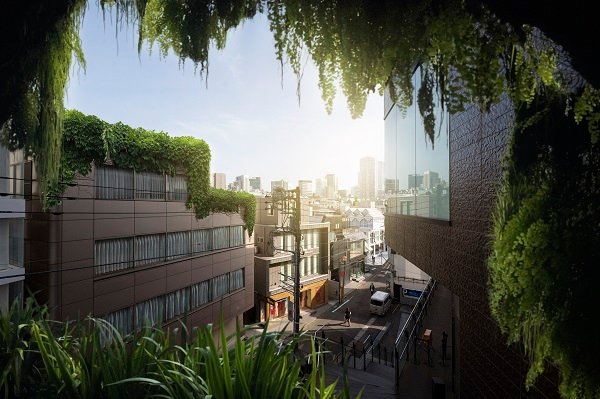Commercial Green Roofs: Xeriscape And Hardscape Opportunities

The importance of greening commercial rooftops is increasing. It is becoming more and more crucial for businesses to consider the environmental impact of their buildings. Greening commercial rooftops means transforming them into green spaces with plants and other elements. This helps to reduce the urban heat island effect, improve air quality, and manage stormwater runoff more effectively.
Xeriscape and hardscape are two important elements in greening commercial rooftops. Xeriscape refers to using drought-tolerant plants that require less water for landscaping. Hardscape, on the other hand, involves using non-living features like pathways, seating areas, and structures. These elements play a significant role in creating functional and attractive rooftop spaces.
In this article, we will explore the opportunities and benefits of commercial green roofs with xeriscape and hardscape elements, highlighting how these eco-friendly features can transform urban spaces into vibrant, sustainable environments.
Contents
Xeriscape Opportunities For Commercial Roofs
1. Plant selection and considerations
When selecting plants for commercial rooftops, it’s important to choose drought-tolerant species that can thrive in rooftop environments. These plants are resilient and require less water, making them well-suited for rooftop gardens.
Factors like weight restrictions, soil depth, and exposure to sunlight should be considered to ensure the plants’ successful growth.
2. Irrigation And Water Management
Effective irrigation and water management are crucial for rooftop gardens. Implementing efficient irrigation systems specifically designed for rooftop environments helps conserve water and ensure proper hydration for the plants.
Exploring options like rainwater harvesting and greywater recycling can further reduce the reliance on traditional water sources and promote sustainability.
3. Design Elements And Aesthetic Considerations
Design elements play a significant role in creating visually appealing rooftop spaces. Incorporating greenery through container gardens, vertical walls adorned with plants, and planter boxes adds depth and natural beauty to the rooftop environment.
To enhance the visual appeal, consider using a variety of textures, colors, and plant arrangements that create a harmonious and vibrant rooftop landscape.
Hardscape Opportunities For Commercial Rooftops
1. Functional Considerations
When exploring hardscape opportunities for commercial green roofs, it’s important to consider functionality. This involves creating pathways and seating areas that are easily accessible to people.
Incorporating amenities like outdoor seating, shade structures, and recreational spaces can enhance the rooftop experience for employees or visitors.
2. Material Selection And Durability
Material selection and durability are key considerations for hardscape elements on commercial rooftops. Choosing hardscape materials that can withstand rooftop conditions, such as exposure to sunlight, wind, and temperature variations, is essential. It’s also worth exploring sustainable and eco-friendly hardscape options to align with environmental goals.
3. Safety And Structural Considerations
Safety and structural considerations are vital when implementing hardscape features on commercial green roofs. Ensuring proper load-bearing capacity and structural integrity is crucial to support the weight of hardscape elements and any potential foot traffic. Incorporating safety features like guardrails and slip-resistant surfaces helps prevent accidents and ensures a secure rooftop environment.
You would like to read this as well – Landscape Design and Ideas for Residential and Commercial Properties
Benefits Of Greening Commercial Rooftops
Environmental Benefits
1. Reduction Of Urban Heat Island Effect
Greening rooftops helps in reducing the urban heat island effect. By adding vegetation and hardscape elements, the temperature of the rooftop and the surrounding area can be lowered, creating a cooler microclimate.
2. Improved Air Quality And Carbon Sequestration
Green rooftops contribute to improved air quality. Plants naturally filter pollutants from the air, reducing harmful particles and improving overall air quality in urban areas. Additionally, they absorb carbon dioxide, a greenhouse gas, and release oxygen, aiding in carbon sequestration.
3. Mitigation Of Stormwater Runoff
One significant benefit of green rooftops is the mitigation of stormwater runoff. The plants and hardscape elements capture rainwater, reducing the burden on stormwater management systems. This helps to prevent flooding and erosion while promoting natural water infiltration.
Economic Benefits
1. Energy Efficiency And Reduced Cooling Costs
Green rooftops enhance energy efficiency by reducing the need for excessive cooling. The plants provide natural insulation, reducing heat transfer and lowering the demand for air conditioning. This results in reduced energy consumption and lower cooling costs for the building owners.
2. Extended Roof Lifespan And Reduced Maintenance Expenses
The lifespan of a roof can be extended through the installation of green elements. The plants act as a protective layer, shielding the roof from harsh weather conditions and UV radiation. As a result, the roof requires less frequent repairs and replacement, leading to reduced maintenance expenses over time.
3. Potential For Financial Incentives And Tax Credits
There is the potential for financial incentives and tax credits for businesses that invest in greening their rooftops. Some municipalities or governments offer incentives to promote sustainable practices, such as grants, rebates, or tax credits. These incentives can help offset the initial costs of implementing green rooftop features and provide a long-term return on investment.
Challenges And Considerations
1. Structural And Engineering Challenges Can Arise When Greening Commercial Rooftops:
- The weight of added vegetation and hardscape elements must be carefully assessed to ensure the structure can support the extra load.
- Structural modifications or reinforcements may be required to accommodate the added weight and maintain the building’s integrity.
- Engineering considerations include factors like drainage, water runoff management, and irrigation system design to prevent leaks or damage.
2. Maintenance And Upkeep Requirements Are Important To Consider:
- Regular maintenance is needed to ensure the health and vitality of rooftop vegetation, including watering, pruning, fertilizing, and pest control.
- Irrigation systems and drainage must be regularly inspected and maintained to avoid water leakage or clogging.
- Access to the rooftop for maintenance purposes, such as for pruning or repairs, should be planned and implemented.
3. Regulatory And Permitting Considerations May Apply:
- Local building codes and regulations must be reviewed to ensure compliance with requirements related to structural modifications, fire safety, and access.
- Permits or approvals may be necessary from local authorities or building management before implementing green rooftop features.
- It’s important to consult with relevant stakeholders and professionals to navigate any legal or regulatory considerations.
4. Cost Considerations And Return On Investment Should Be Evaluated:
- Greening commercial rooftops can involve upfront costs for materials, installation, and maintenance.
- It’s essential to assess the potential long-term benefits and cost savings, such as energy efficiency, reduced maintenance expenses, and potential incentives or tax credits.
- Conducting a thorough cost-benefit analysis and considering the return on investment over the expected lifespan of the rooftop greening project is crucial.
Conclusion,
Greening commercial rooftops with xeriscape and hardscape elements provides numerous benefits and opportunities. We have explored how these initiatives can reduce the urban heat island effect, improve air quality, mitigate stormwater runoff, enhance energy efficiency, extend roof lifespan, and potentially lead to financial incentives. By incorporating drought-tolerant plants, efficient irrigation systems, and visually appealing design elements, businesses can create vibrant and sustainable rooftop spaces.
By investing in green rooftop initiatives, businesses can demonstrate their commitment to sustainability and contribute to a greener future. For creating a green rooftop business can take help from the best commercial xeriscape landscaping and hardscaping services provider company.









